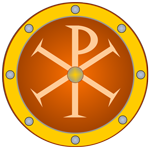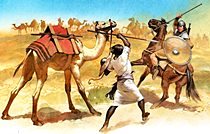
Battle of Mammes(Battle of Mamma) |
year: 534Spring 534 |
| A Byzantine victory against Moorish rebels in a battle with unusual tactics | ★ ★ ★ ★ ★ |
|
enemy: Berbers
|
location: In central Tunisia south of the modern town Aïn Djeloula of Kairouan Governorate
|
accuracy:
●●●●●
|
|
battle type: Pitched battle |
war: Berber Tribes Rebellions |
modern country:
Tunisia |
| ▼ The Byzantines(emperor: Justinian I) | ▼ The Enemies | |
| Commander: | Solomon (Carthage governor) | Cutzinas, Esdilasas, Iourphouthes, Mesidinissas |
| Forces: | 18,000 | 50,000 |
| Losses: | more than 10,000 |
| Background story: |
| In 533-534, general Belisarius defeated and destroyed the Vandal Kingdom that had existed in the former Roman territories of Northern Africa since 435. After this success, emperor Justinian founded a new major administrative division: the praetorian prefecture of Africa (praefectura praetorio Africae). Many lands of the old Roman provinces remained in the hands of various Berber tribes, collectively called the Mauri (Moors). The Moors however pledged loyalty to the Byzantine empire as Belisarius apparently promised to share with them the loot from the fallen Vandal kingdom. Belisarius finished his mission in Africa and left. He was succeeded as magister militum Africae by his domesticus (chief-of-staff), the eunuch Solomon from Daras. The tribes of Mauri living in Byzacena and Numidia almost immediately revolted. After that, Solomon was promoted to the civil office of praetorian prefect (governor of the province) and received reinforcements from Justinian. |
The Battle: |
 With the newly arrived Byzantine troops and with the aide of warriors from other Moorish tribes, Solomon gathered an army of 18,000 and marched towards Byzacena in Spring 535. He reached a location called Mammes where the four Moorish chiefs Cutzinas, Esdilasas, Iourphouthes and Mesidinissas had encamped Solomon preferred not to attack and made a stockade. The Moors had formed a circle with their camels. They placed the women and the children inside the circle (for among the Moors was customary to take some of their women and some of their children to battle to perform auxiliary tasks like building huts and tending horses). The Moors took their stand on foot in between the legs of the camels armed with swords, spears and low-tech shields. Some of them with their horses stayed hidden in the mountain behind their circle. Solomon placed no one against the side of the circle of the Moors that was towards the mountain fearing that a force might come down and then he would be under attack from two sides. The battle didn’t start well for the Romans. Their horses were disturbed by the noise and sight of the camels reared up throwing away their riders. At the same time the Moors were attacking hurling all the spears they had. They were hitting the Romans who were unable to defend themselves and to hold their positions. Seeing this disorder, Solomon ordered all his men to get off their horses and stand still under the protection of their shields. Then, Solomon himself led a counter attack of a group of 500 men against a small part of the enemy circle. He commanded his men to draw their swords and target the camels. Around 200 camels were killed and the Moors at that point started to flee, so the circle was breached. The Romans advanced to the center of the circle where the women and children were. The crowd of the Moors panicked and fled to the mountain. The Romans chased them and slaughtered more than 10,000. |
Noteworthy: |
| The historian Procopius records an exchange of very interesting speeches of the leaders of the two armies to their men. This exchange alludes to the exchange before the battle of Nafpaktos in Thucydides. |
Aftermath: |
| Solomon and his army returned to Carthage in triumph, but there news came that the Moors, regrouped fast and seeking revenge had attacked and overrun Byzacena again. Solomon had to go back. |
|
|
